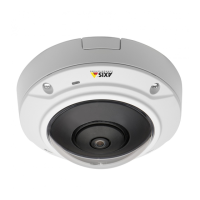
Do you have a question about the Axis M3007–PV and is the answer not in the manual?
| Total megapixels | 5 MP |
|---|---|
| Maximum resolution | 2592 x 1944 pixels |
| Supported video modes | - |
| Video formats supported | H.264 |
| Angle of rotation | 180 ° |
| Minimum illumination | 0.6 lx |
| Field of view (FOV) angle | 187 ° |
| Sensor type | CMOS |
| Optical sensor size | 1/3.2 \ |
| Optical zoom | - x |
| IP address filtering | Yes |
| Built-in HDD | No |
| Flash memory | 128 MB |
| Type | IP security camera |
| Certification | EN 55022 Class B, EN 61000-6-1, EN 61000-6-2, EN 55024, FCC Part 15 Subpart B Class B, ICES-003 Class B, VCCI Class B, C-tick AS/NZS CISPR 22, KCC Class B, IEC/EN/UL 60950-1, IEC 60529 IP42, IEC 62262 Class IK08 |
| Placement supported | Indoor |
| Connectivity technology | Wired |
| Form factor | Dome |
| Mounting type | Ceiling/wall |
| Product color | White |
| International Protection (IP) code | IP42 |
| Interface | RJ-45 |
| Ethernet LAN (RJ-45) ports | 1 |
| Cabling technology | 10/100Base-T(X) |
| Supported network protocols | IPv4/v6, HTTP, HTTPS, SSL/TLS, QoS Layer 3 DiffServ, FTP, CIFS/SMB, SMTP, Bonjour, UPnP, SNMPv1/v2c/v3(MIB-II), DNS, DynDNS, NTP, RTSP, RTP, TCP, UDP, IGMP, RTCP, ICMP, DHCP, ARP, SOCKS |
| Power source type | PoE |
| Power consumption (typical) | 4.6 W |
| Weight | 610 g |
|---|---|
| Cable length | 2 m |
Details the physical connectors and buttons on the camera, including the network connector and focus ring.
Describes the SD card slot and the function of the control button for reset and service connection.
Explains the meaning of the status LED lights for different operational states like connection and firmware upgrade.
Step-by-step guide to accessing the camera's web interface via a web browser.
Steps to enable remote access to the camera over the internet by configuring the network router.
Setting the root password and camera orientation for initial use and security.
Overview of controls and features available on the live view page, including media and PTZ functions.
Detailed explanation of different H.264 streaming protocols and configurations.
Information on using the Motion JPEG video stream format for high image quality.
Recommended method for viewing live video using AXIS Media Control and other access methods.
Overview of essential setup steps before product use, like user, TCP/IP, date/time, video.
Configuring various video stream settings like image quality, format, and direction.
Adjusting color, brightness, sharpness, white balance, and exposure for optimal image quality.
Adding text/image overlays and setting up privacy masks to protect sensitive areas.
Selecting the preferred viewer for different browsers and configuring viewer options.
Adding user-defined links and controlling output buttons from the live view page.
Creating, accessing, and using saved camera positions for quick steering.
Setting up automated camera tours between preset positions.
Configuring advanced PTZ controls and panel shortcut buttons.
Configuring the camera to detect tampering events like repositioning or lens cover.
Setting up action rules to trigger alarms when camera tampering is detected.
Managing licenses for installed third-party applications and uploading them.
Configuring and using the built-in video motion detection application for object detection.
Defining conditions and actions for automated events like motion detection or tampering.
Overview of available triggers (input signal, PTZ, system) and actions (overlay, PTZ control, record).
Configuring recipients, schedules, and recurrences for event notifications.
How to locate, filter, and play back recorded video clips.
Exporting recorded clips as video files and setting up continuous recording.
Procedure for uploading and selecting languages for the user interface and help.
Managing user accounts, access levels, ONVIF, and IP address filtering for system security.
Configuring HTTPS, certificates, and IEEE 802.1X for secure network access.
Setting the product's date and time, including synchronization with computer or NTP servers.
Setting up IP addresses (DHCP, static, ARP/Ping) and basic network parameters.
Configuring DNS, NTP, hostnames, HTTP/HTTPS ports, and link-local addresses.
Configuring NAT traversal, FTP, RTSP, and SOCKS for network access and communication.
Configuring QoS, SNMP, and UPnP for network traffic prioritization and management.
Configuring RTP ports, multicast, and Bonjour for media streaming.
Managing SD card insertion, file systems, and storage operations.
Formatting SD cards and enabling data encryption for security.
Configuring network shares and performing system maintenance like restart and reset.
Accessing system overview, logs, reports, and support resources for assistance.
Utilizing file uploads, Plain Config, and factory reset procedures for advanced users.
Verifying firmware version and performing firmware upgrades.
Steps to recover the product if firmware upgrade fails or connection is lost.
Addressing issues like IP address problems, login failures, and certificate errors.
Troubleshooting external accessibility, H.264 streaming, and general video/image problems.
Resolving problems related to storage device availability, recording, and SD card mounting.
Factors affecting system performance, bandwidth, and frame rate.